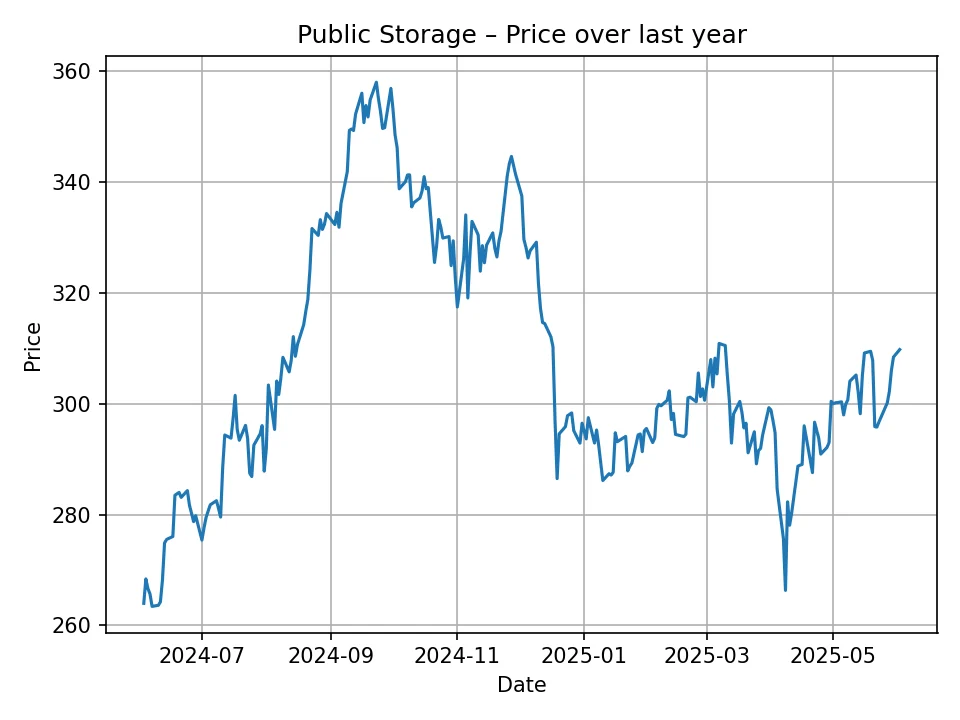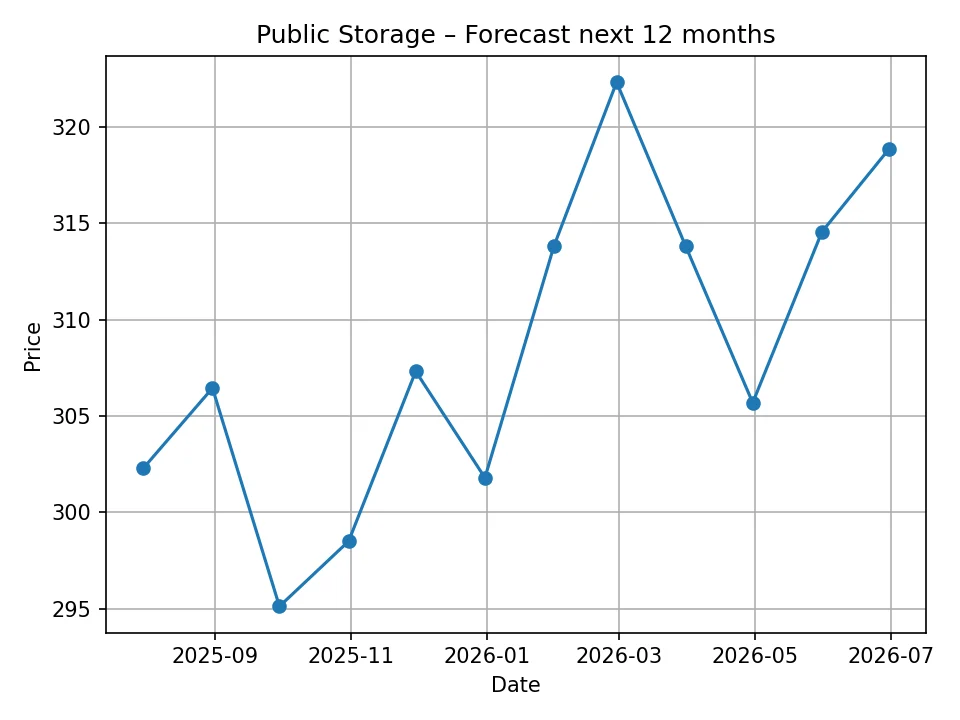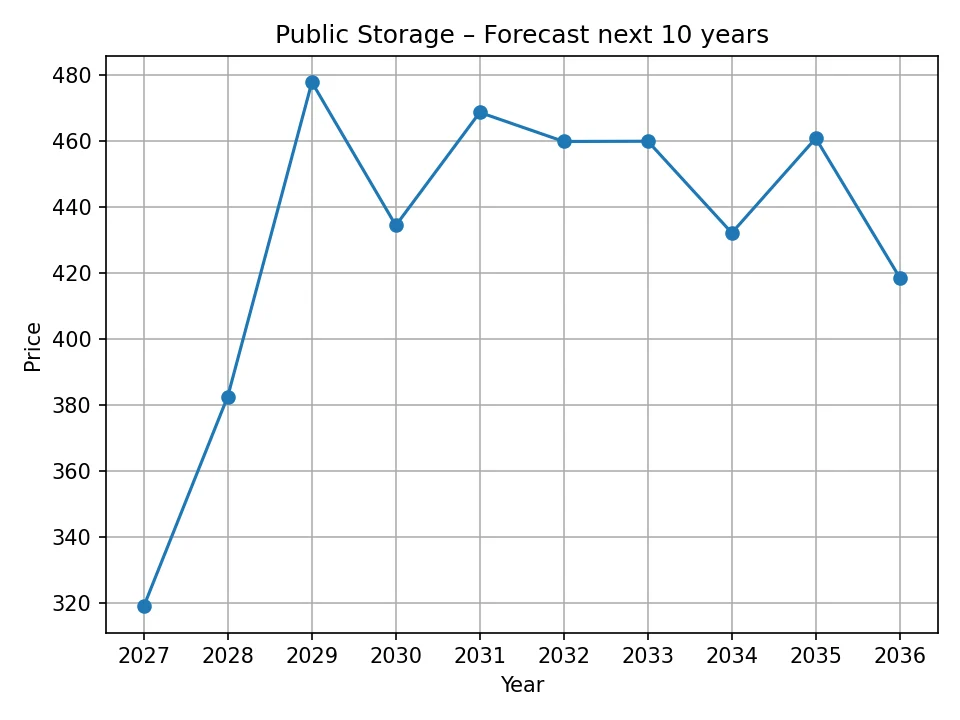Public Storage (NYSE: PSA) stands as a prominent pillar in the Real Estate Investment Trust (REIT) sector, specifically dominating the self-storage industry. With its vast network of properties across the United States and parts of Europe, Public Storage plays a crucial role in providing flexible storage solutions for individuals and businesses alike. As of the current date, June 3, 2025, Public Storage’s stock trades at 309.77 USD, reflecting its position as a mature and resilient asset within the often-volatile real estate market. Understanding the future trajectory of PSA’s stock price requires a comprehensive analysis of its historical performance, the broader economic landscape, and specific industry trends that influence demand for self-storage facilities. This article delves into a detailed price forecast for Public Storage, leveraging historical data and an advanced proprietary algorithmic model, the Visionary algorithm, to project its potential performance over the next year and the coming decade.
An Overview of Public Storage’s Market Position
Public Storage has established itself as the largest owner and operator of self-storage facilities globally. Its business model is straightforward yet highly effective: acquire, develop, and manage self-storage properties. The company’s strategic locations, extensive brand recognition, and diversified tenant base contribute to its consistent revenue streams. Self-storage, as an asset class, has demonstrated remarkable resilience through various economic cycles, often performing well during periods of both economic expansion (due to increased household formation and business activity) and contraction (due to downsizing, relocation, and life transitions). PSA’s strong balance sheet, investment-grade credit rating, and a history of dividend payouts further solidify its appeal to income-focused investors and those seeking stability in their portfolios. The company’s ongoing efforts in portfolio optimization, digital transformation, and strategic acquisitions are key drivers for its long-term growth prospects.
Historical Performance Analysis: A Look Back at the Past 12 Months

To truly grasp the potential future movements of Public Storage’s stock, it is essential to examine its recent past. Over the last 12 months, PSA’s stock has experienced notable fluctuations, characteristic of the broader real estate and interest-rate sensitive sectors. The stock began its journey in June 2024 at approximately 263.97 USD. Following this, it embarked on a significant upward trend, driven by factors such as anticipated interest rate stabilization and strong demand in the self-storage market. PSA reached its 12-month peak in late 2024, trading around the 358 USD mark. This period of robust growth showcased investor confidence in the self-storage sector’s enduring appeal and Public Storage’s operational strengths.
However, the stock also encountered periods of correction and consolidation. After reaching its highs, PSA saw a notable decline in early 2025, retreating into the 280-290 USD range. This correction can be attributed to various market dynamics, including shifts in macroeconomic outlooks, revised interest rate expectations, and broader sector-specific headwinds. Despite these pullbacks, Public Storage has demonstrated a tendency for recovery, climbing back to its current price of 309.77 USD. The 12-month historical data reveals a pattern of resilience, where dips are often followed by periods of steady appreciation, underscoring the underlying demand for self-storage and the company’s strong operational foundation. The stock’s journey from a 12-month low of around 263 USD to its high of 358 USD and then its current position reflects both the market’s volatility and Public Storage’s capacity to navigate it.
Key Factors Influencing Public Storage’s Stock Price
Several critical factors are at play when forecasting the price movements of Public Storage. These can be broadly categorized into macroeconomic trends, real estate market dynamics, and company-specific operational performance.
First, interest rates are a significant determinant for REITs like Public Storage. Higher interest rates can increase borrowing costs for expansion and acquisitions, potentially compressing net operating income and impacting property valuations. Conversely, a stable or declining interest rate environment can provide a tailwind, making REITs more attractive to investors seeking yield. Inflation also plays a dual role: while it can increase operational costs, it can also lead to higher rental rates for storage units, which can mitigate some of the negative effects.
Second, the overall real estate market conditions, particularly in the commercial and residential sectors, directly influence demand for self-storage. Housing market activity, including home sales and rentals, often correlates with self-storage demand as people move and need temporary or long-term solutions for their belongings. Urbanization trends, remote work shifts, and demographic changes (such as an aging population downsizing) also contribute to the ongoing need for storage space.
Third, industry-specific supply and demand dynamics within the self-storage sector are crucial. Over-supply in certain markets can lead to pricing pressures and lower occupancy rates. However, Public Storage’s expansive footprint and strategic market positioning often allow it to maintain competitive advantages. The increasing trend of e-commerce, which requires warehousing and inventory management, also presents new avenues for demand from small and medium-sized businesses.
Finally, Public Storage’s operational strategies are paramount. This includes their ability to effectively manage their vast portfolio, optimize occupancy rates, implement technology for customer convenience (e.g., online rentals, smart access), and execute successful acquisitions. Dividend policy and financial health, including debt levels and cash flow generation, also weigh heavily on investor sentiment. A strong financial footing allows the company to weather economic uncertainties and seize growth opportunities.
Short-Term Price Forecast: The Next 12 Months
Our proprietary Visionary algorithm provides a detailed outlook for Public Storage’s stock price over the next 12 months. This short-term projection indicates a dynamic period, with expected fluctuations that reflect ongoing market adjustments but an underlying positive trend.
Based on the Visionary algorithm’s analysis, the monthly forecast for Public Storage (PSA) is as follows:

Public Storage (PSA) Monthly Price Forecast (July 2025 – June 2026)
| Month | Projected Price (USD) |
|---|---|
| July 2025 | 302.29 |
| August 2025 | 306.45 |
| September 2025 | 295.13 |
| October 2025 | 298.51 |
| November 2025 | 307.32 |
| December 2025 | 301.80 |
| January 2026 | 313.84 |
| February 2026 | 322.31 |
| March 2026 | 313.80 |
| April 2026 | 305.69 |
| May 2026 | 314.55 |
| June 2026 | 318.84 |
The forecast suggests an initial slight dip in July 2025 to 302.29 USD, followed by a partial recovery in August. September 2025 indicates a more notable pullback to 295.13 USD, which could represent a period of market recalibration or seasonal weakness. However, the model projects a strong rebound in November, reaching 307.32 USD, and then a significant uptrend into early 2026. The price is anticipated to climb to 313.84 USD in January 2026 and further to 322.31 USD by February 2026, marking the highest point in this 12-month projection. While there are some projected pullbacks in March and April 2026, the overall trajectory points towards a healthy recovery and gradual appreciation, concluding the 12-month period in June 2026 at 318.84 USD. This represents a modest but steady gain from the current price, indicating that PSA’s stock is expected to navigate short-term volatility to achieve incremental growth.
Long-Term Price Forecast: The Next Decade (2026-2035)
Looking beyond the immediate horizon, the Visionary algorithm provides a compelling long-term price forecast for Public Storage, extending through 2035. This projection suggests significant growth potential, albeit with expected periods of consolidation and adjustment. The self-storage sector is anticipated to continue its expansion, driven by evolving consumer needs and the company’s strategic positioning.
Here is the long-term annual forecast for Public Storage (PSA) stock:

Public Storage (PSA) Annual Price Forecast (2026 – 2035)
| Year | Projected Price (USD) |
|---|---|
| 2026 | 318.84 |
| 2027 | 382.51 |
| 2028 | 477.87 |
| 2029 | 434.41 |
| 2030 | 468.71 |
| 2031 | 459.89 |
| 2032 | 459.96 |
| 2033 | 432.15 |
| 2034 | 460.87 |
| 2035 | 418.61 |
The long-term forecast paints a picture of substantial capital appreciation for Public Storage. Building on the 2026 projection of 318.84 USD, the stock is anticipated to experience robust growth in the subsequent years. A significant surge is predicted in 2027, with the price potentially reaching 382.51 USD. This upward momentum is expected to continue strongly into 2028, where the Visionary algorithm forecasts PSA to peak at an impressive 477.87 USD. This potential peak signifies strong market confidence and favorable conditions for the self-storage industry in the medium term.
Following this peak, the forecast indicates a period of correction in 2029, with the price adjusting to 434.41 USD. Such pullbacks are typical in long-term equity projections, representing market re-evaluations or shifts in economic cycles. The stock is then projected to recover and show renewed strength, reaching 468.71 USD by 2030, suggesting continued underlying demand and operational efficiency. The years 2031 and 2032 show relative stability around the 460 USD mark, before another predicted adjustment in 2033 to 432.15 USD. The decade is forecasted to conclude with a recovery to 460.87 USD in 2034, followed by another dip to 418.61 USD in 2035.
Overall, the long-term outlook for Public Storage is overwhelmingly positive, with the stock projected to deliver substantial gains from its current price. Despite the anticipated fluctuations, the general trend indicates that Public Storage is well-positioned to capitalize on enduring demand for self-storage and its strong market leadership, potentially offering significant returns for long-term investors.
Potential Risks and Opportunities for Public Storage
While the forecast for Public Storage appears favorable, it is crucial for investors to consider both the potential risks and opportunities that could impact its actual performance.
On the risk side, rising interest rates remain a perennial concern for REITs. Sustained high rates could increase PSA’s borrowing costs for expansion and refinancing existing debt, potentially impacting its profitability and dividend growth. Oversupply in specific self-storage markets is another risk. If new construction outpaces demand in certain areas, it could lead to increased competition, lower occupancy rates, and pressure on rental pricing. A significant economic downturn or recession could also reduce demand for self-storage as individuals and businesses cut back on discretionary spending and relocation activity slows. Furthermore, intense competition from other large operators and smaller local players could erode market share or necessitate aggressive pricing strategies. Lastly, changes in regulatory frameworks or property taxes could negatively impact the company’s operational costs and profitability.
However, Public Storage is also presented with several compelling opportunities. The continued demographic shifts and evolving consumer lifestyles, such as increased urban living, downsizing, and the rise of e-commerce, are fundamental drivers for self-storage demand. PSA’s extensive footprint and brand recognition position it well to capture this sustained growth. The company’s financial strength provides it with the capacity for strategic acquisitions and portfolio expansion, allowing it to consolidate its market leadership and enter new, underserved markets. Technological advancements, including online rental platforms, smart access systems, and data analytics for dynamic pricing, offer avenues for enhancing operational efficiency and customer experience. Additionally, Public Storage’s commitment to sustainability initiatives and green building practices could appeal to a growing segment of environmentally conscious investors and tenants, potentially enhancing its brand value and operational longevity. Diversification into different types of storage or related services could also unlock new revenue streams.
Conclusion
Public Storage (PSA) remains a cornerstone in the resilient self-storage REIT sector. With a current stock price of 309.77 USD, the company has demonstrated its ability to navigate various economic conditions and maintain a strong market presence. Our analysis of historical data reveals a pattern of both growth and periodic corrections, reflecting the dynamic nature of the real estate market.
The short-term price forecast, powered by the Visionary algorithm, suggests that while PSA may experience some fluctuations over the next 12 months, including minor dips and recoveries, the overall trend points towards a gradual appreciation, culminating around 318.84 USD by June 2026. This indicates a steady and healthy performance in the immediate future.
Looking at the long-term horizon, the Visionary algorithm’s projections are notably optimistic. Public Storage’s stock is forecasted to achieve substantial growth over the next decade, with a significant peak projected in 2028 at an impressive 477.87 USD. While the model anticipates periods of consolidation and price adjustments throughout the decade, the overarching trajectory remains strongly positive. This long-term outlook is underpinned by the enduring demand for self-storage solutions, Public Storage’s robust operational capabilities, and its strategic position within a resilient asset class. Investors considering PSA should weigh these forecasts against the inherent risks and capitalize on the opportunities presented by this leading self-storage REIT.
Disclaimer: The price forecasts provided in this article for Public Storage (PSA) are generated using a proprietary algorithmic model, the Visionary algorithm. These projections are based on historical data and various market assumptions, and as such, they are speculative in nature. Stock prices are subject to numerous unforeseen market forces, economic changes, and company-specific events that can cause significant deviations from any forecast. We do not guarantee the accuracy or completeness of these forecasts, and we are not responsible for any investment decisions made based on this information. Investing in financial markets involves risks, and past performance is not indicative of future results. It is highly recommended that readers conduct their own thorough research and consult with a qualified financial advisor before making any investment decisions.

Oliver brings 12 years of experience turning intimidating financial figures into crystal-clear insights. He once identified a market swing by tracking a company’s suspiciously high stapler orders. When he’s off the clock, Oliver perfects his origami… because folding paper helps him spot market folds before they happen.